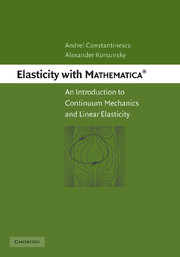Book contents
- Frontmatter
- Contents
- Acknowledgments
- Introduction
- 1 Kinematics: displacements and strains
- 2 Dynamics and statics: stresses and equilibrium
- 3 Linear elasticity
- 4 General principles in problems of elasticity
- 5 Stress functions
- 6 Displacement potentials
- 7 Energy principles and variational formulations
- Appendix 1 Differential operators
- Appendix 2 MATHEMATICA® tricks
- Appendix 3 Plotting parametric meshes
- Bibliography
- Index
2 - Dynamics and statics: stresses and equilibrium
Published online by Cambridge University Press: 11 November 2009
- Frontmatter
- Contents
- Acknowledgments
- Introduction
- 1 Kinematics: displacements and strains
- 2 Dynamics and statics: stresses and equilibrium
- 3 Linear elasticity
- 4 General principles in problems of elasticity
- 5 Stress functions
- 6 Displacement potentials
- 7 Energy principles and variational formulations
- Appendix 1 Differential operators
- Appendix 2 MATHEMATICA® tricks
- Appendix 3 Plotting parametric meshes
- Bibliography
- Index
Summary
OUTLINE
In this chapter we consider the force equilibrium in a continuous body under the assumption that the underlying deformation is adequately described by the small strain hypothesis. The principle of virtual power occupies a central place in this treatment, since it offers a rational basis for developing equations that apply to a continuum in a state of equilibrium. Furthermore, the concept of stress arises naturally from this analysis as dual to small strain for a solid continuum. Stress equilibrium and traction boundary conditions also appear in the most convenient invariant form. For illustration, virtual power expressions are given for systems obeying different kinematics, such as inviscid fluid flow or beams in simple bending, and the resulting stresslike quantities and their equilibrium equations are readily derived. Cauchy's stress principle and the Cauchy–Poisson theorem are also given.
Once it is established that equlibrium stress states in continuum solids in the absence of body forces are given by divergence-free tensors, the representation of such tensor fields is addressed. Beltrami potential representation of divergence-free tensors is considered, and Donati's theorem is introduced to illustrate a certain duality that exists between stress equilibrium and strain compatibility conditions.
FORCES AND MOMENTA
A body may be subject to a system of exterior forces of the following types:
Body force f is described by a vector field distributed over the entire volume of body Ω. Denoting body force by the vector f (x, t) represents the fact that the force f (x, t)dv acts on an infinitesimal volume dv at point x at time t. An example of the body force is the force of gravity.
[…]
- Type
- Chapter
- Information
- Elasticity with Mathematica ®An Introduction to Continuum Mechanics and Linear Elasticity, pp. 41 - 55Publisher: Cambridge University PressPrint publication year: 2007

